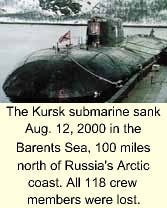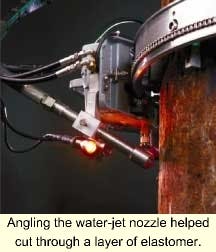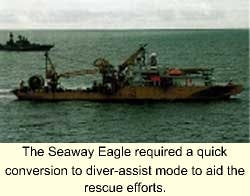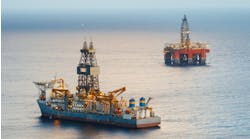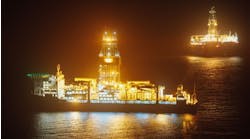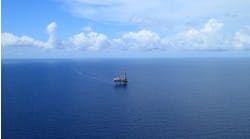The Kursk submarine sank Aug. 12, 2000 in the Barents Sea, 100 miles north of Russia's Arctic coast. All 118 crew members were lost.
The Russian naval submarine Kursk experienced an unexplained catastrophe during naval exercises on August 12, 2000 and sank to the bottom of the Barents Sea. The location was 100 miles north of Russia's Arctic coast. Extensive rescue efforts focused on using a deep sea rescue vehicle (DSRV) to dock with one of the Kursk's emergency rescue hatches.
Unfortunately, the submarine's heeled-over position on the seafloor, poor visibility, and other problems hampered these efforts. Although, the hatch was finally opened on August 21, there were no survivors and the crew was given up as lost.
In September, Russian naval officials announced plans to enter the submarine and recover as many bodies as possible and to try to determine what caused the vessel to sink. The sub rested at a depth of 353 ft and could be reached by divers working in saturation mode. However, several obstacles had to be overcome:
- Limited visibility and the threat to divers presented by jagged metal, which could tear pressure suits
- Approaching winter storms, which begin in November in the Barents Sea, limited the amount of time for the operation.
- Since divers could not negotiate the narrow hatches and passageways in the submarine, there was the problem of how to cut through the submarine's two hulls to provide diver access directly into the vessel's compartments
Contracts go out
Angling the water-jet nozzle helped cut through a layer of elastomer.
The Russians contracted with Halliburton AS, project manager, to provide entry to the vessel and retrieve hull samples for analysis. Halliburton AS is the Norwegian subsidiary of Halliburton, Inc. On October 7, Oil States MCS, Ltd. (Barrow-in-Furness, UK), received an inquiry concerning the use of an abrasive water-jet cutting system introduced in the early 1990s by Oil States MCS Inc. of Houston.
The abrasive water-jet cutting system was developed primarily for use in severing pilings to salvage offshore structures and in severing oilfield tubulars for well abandonment. Internal and external manipulators are available for cutting cylindrical shapes, and surface-mounted manipulators are used for cutting through flat surfaces, such as large process vessels and storage tanks.
The cutting system uses a high-energy jet of water-borne abrasive particles to cut the hardest steel alloys and composite materials up to several inches thick. The system works underwater and poses no environmental risk. Abrasive is mixed with water and then pumped as a slurry through a single high-pressure hose to the cutting head. The system used on the Kursk project works at 14,700 psi. The hose can be up to 1,000 ft long, permitting the cutting head to be placed far from the slurry mixing equipment and pump. The system was operated by an engineer and a technician would be responsible for operating the cutting system at the surface and monitoring progress.
Racing winter storms
Three days after contract award, the assembled system was used to cut a test piece representative of the submarine's hull. Surface- mounted manipulators, one track-type and one radius-arm (6.6 ft) were furnished by Norse Cutting of Stavanger. The six-hour test was successful and the system was trucked to Honningsvag, Norway, a city located above the 70th parallel. The expedited schedule was necessary to ensure project completion before the onset of the November winter storms.
When it arrived at the port, the cutting system was transferred to the marine support vessel MSV Regalia, from which the operations were carried out. On October 18, the MSV Regalia sailed from Honningsvag, arriving on location above the Kursk on October 20. Workers there were reminded of the tragic nature of the project when Russian dignitaries and several relatives of Kursk crew members boarded the work vessel for a memorial service in honor of the lost crew.
Cutting begins
On October 21, cutting operations began. For the next four weeks, divers and surface personnel coordinated to complete 14 cuts on the hull of the submarine. Total actual cutting time over the 28 days was 33.5 hours. The cuts were visually monitored from the surface via a video camera mounted on the cutting head. A total of 18 divers, nine Russian and nine Norwegian, were involved in the project.
First, as a safety measure, three cuts were made to relieve pressure from the submarine's high-pressure air ballast system. Then, four diver-access cuts were made through the submarine's superstructure (outer hull). After divers cleared piping, cables and other obstructions, four diver-access holes, 1.2-1.5 meters in diameter, were cut through the inner, two-inch thick pressure hull.
These holes, which provided Russian divers access to the inside of the submarine, were completed in about an hour each. In addition, three coupons were cut from the superstructure for later analysis by Russian scientists, who are trying to reconstruct the accident. For these cuts, the nozzle was set at an angle, so that the coupons would not fall through after the cut was completed.
Much of the non-cutting time was spent modifying manipulators to work in unforeseen situations and making preparations for cuts. In one case, the superstructure surface, instead of being flat, was S-shaped; requiring the divers to manually adjust the stand-off of the cutting nozzle as the cut progressed. In making the pressure-hull cuts, the manipulators had to be modified to work in the confined space between the superstructure and the pressure hull. All of these situations, however, were easily overcome.
Sound-attenuation layer
an abrasive 14,700 psi water-jet cutting system was used to open the Kursk's hull. The system was originally developed to sever pilings during salvage of offshore structures.
Cutting through the superstructure was difficult initially, due to the nature of the 80-mm thick elastomer sound-attenuation layer bonded to the outside of the 10-mm steel plate. In the test at Stavanger, the elastomer layer had been solid, which helped keep the cutting jet focused and effective.
On the submarine, however, only the top 20 mm of the elastomer was solid, with the rest being honeycombed, which diffused the cutting jet and reduced cutting efficiency. The problem was solved by angling the cutting nozzle to cut a V-shaped section from the elastomer. After divers removed this section, they readjusted the nozzle to vertical and adjusted the stand-off to make the final cuts through the underlying metal.
Project completion
After Russian divers recovered eight bodies from three compartments, the project was terminated because of low visibility and the risk to divers. Plans were then announced to raise the Kursk during the summer of 2001.
Throughout the project, the only cutting equipment problems were minor and easily corrected with the manipulators. At the end of the project, on November 7, all of the participating workcrews joined in a farewell ceremony, out of respect for crew of the Kursk, their families, and countrymen.
Seaway Eagle participates in Kursk rescue effort
The Seaway Eagle required a quick conversion to diver-assist mode to aid the rescue efforts.
The Stolt Offshore vessel, Seaway Eagle, was installing risers on the Asgard Field for Statoil on August 16, 2000 when it was called to aid in the Kursk submarine rescue. The robotic equipment it was using had to be removed and replaced with diving-support modules as it traveled to the Barents Sea site of the sinking. This required compressing a normal two-week operation into two days.
With the help of the Norwegian military, the vessel made equipment changeover arrangements while moving through Arctic waters. The military also set up a DGPS navigation chain for the vessel's dynamic positioning system, before it arrived on station over the stricken submarine.
Sixty tons of dive-gas were flown to Tromso, Norway by a Hercules air transport. Personnel and associated equipment met the vessel at Tromso and were transferred during a three-hour layover. At the same time a hyperbaric lifeboat for saturation diving with required launch davits was shipped by Antonov aircraft to Kirkens, Norway. The vessel loaded the equipment at Kirkens before its final transit to the site.
The vessel arrived at the site on August 19 and assisted the Russian Navy in attempting to land a rescue vessel on the Kursk's escape hatch. Divers initially surveyed the aft of the submarine for radiation leaks. When it proved safe, they struck the hull in code as they searched and listened for life-signs. When the aft escape hatch was eventually opened, the vessel was water-filled. There were no survivors. Seaway Eagle left the site on September 22, 2000 for Kirkens where the divers were decompressed.
Stolt Offshore presented a proposal to salvage the Kursk to Russia's Central Design Bureau for Marine Engineering (Rubin). The bureau has made no public announcement regarding the award of the salvage contract.

